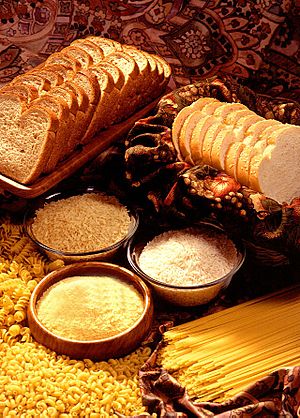Carbohydrate facts for kids

Carbohydrates are chemical compounds that contain only oxygen, hydrogen and carbon. They are made up of joined-up sugars. Sugars have the general formula Cm(H2O)n, and are also known as saccharides.
Certain carbohydrates are an important storage and transport form of energy in most organisms, including plants and animals.
Biochemistry
There are four types of carbohydrates, named by the number of sugar molecules they contain.
- Simple saccharides with one or two sugar molecules
- Monosaccharides: single sugar e.g. glucose , fructose
- Disaccharides: two saccharides. e.g. sucrose, lactose
- Longer chain saccharides:
- Oligosaccharides (shortish chains), often linked to amino acids or lipids. They play a special role in cell membranes.
- Polysaccharides (long chains) are complex carbohydrates, with linear chains of sugars or branched clusters. Their function is either energy storage (starch, glycogen) or building structures (cellulose, chitin).
Nutrition and foods
Carbohydrates are the most common source of energy for the human body. Protein builds tissue and cells in the body. Carbohydrates are very good for energy, but, if a person eats more than needed, the extra is changed into fat.
If necessary, humans can live without eating carbohydrates because the human body can change proteins into carbohydrates. People of some cultures eat food with very little carbohydrates, but they still remain healthy.
Carbohydrates are found in a wide variety of foods. The important sources are cereals (wheat, maize, rice), potatoes, sugarcane, fruits, table sugar(sucrose), bread, milk, etc. Starch and sugar are the important carbohydrates in our diet. Starch is abundant in potatoes, maize, rice and other cereals. Sugar appears in our diet mainly as sucrose(table sugar) which is added to drinks and many prepared foods such as jam, biscuits and cakes. Glucose and fructose are found naturally in many fruits and some vegetables. Glycogen is carbohydrate found in the liver and muscles (as animal source). Cellulose in the cell wall of all plant tissue is a carbohydrate. It is important in our diet as fibre which helps to maintain a healthy digestive system
Research in the United States and Canada have shown that people get about 40% to 60% of their energy from carbohydrates. However, studies suggest that some people get at least 55% to 75% of energy from carbohydrates. It may depend on the amount of physical work done by people: the harder the work, the more energy they need. The other need for energy is body temperature. Living in a cold climate means a person needs more energy.
Some foods have high levels of carbohydrates including bread, pasta, potatoes, and cereals.
Images for kids
-
D-glucose is an aldohexose with the formula (C·H2O)6. The red atoms highlight the aldehyde group and the blue atoms highlight the asymmetric center furthest from the aldehyde; because this -OH is on the right of the Fischer projection, this is a D sugar.
-
Glucose can exist in both a straight-chain and ring form.
-
Sucrose, also known as table sugar, is a common disaccharide. It is composed of two monosaccharides: D-glucose (left) and D-fructose (right).
-
Grain products: rich sources of carbohydrates
See also
 In Spanish: Glúcido para niños
In Spanish: Glúcido para niños






